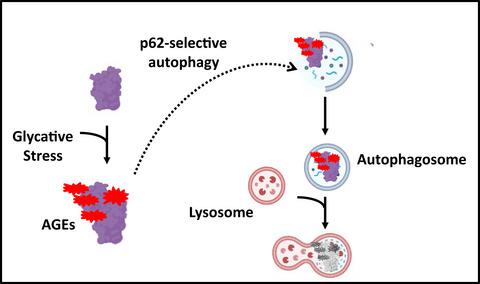当前位置:
X-MOL 学术
›
Aging Cell
›
论文详情
Our official English website, www.x-mol.net, welcomes your feedback! (Note: you will need to create a separate account there.)
Autophagic receptor p62 protects against glycation‐derived toxicity and enhances viability
Aging Cell ( IF 7.8 ) Pub Date : 2020-11-04 , DOI: 10.1111/acel.13257 Gemma Aragonès 1 , Kalavathi Dasuri 1 , Opeoluwa Olukorede 1 , Sarah G Francisco 1 , Carol Renneburg 1 , Caroline Kumsta 2 , Malene Hansen 2 , Shun Kageyama 3 , Masaaki Komatsu 3 , Sheldon Rowan 1 , Jonathan Volkin 1 , Michael Workman 1 , Wenxin Yang 1 , Paula Daza 4 , Diego Ruano 5, 6 , Helena Dominguez-Martín 5, 6 , José Antonio Rodríguez-Navarro 7 , Xue-Liang Du 8 , Michael A Brownlee 8 , Eloy Bejarano 1, 9 , Allen Taylor 1
Aging Cell ( IF 7.8 ) Pub Date : 2020-11-04 , DOI: 10.1111/acel.13257 Gemma Aragonès 1 , Kalavathi Dasuri 1 , Opeoluwa Olukorede 1 , Sarah G Francisco 1 , Carol Renneburg 1 , Caroline Kumsta 2 , Malene Hansen 2 , Shun Kageyama 3 , Masaaki Komatsu 3 , Sheldon Rowan 1 , Jonathan Volkin 1 , Michael Workman 1 , Wenxin Yang 1 , Paula Daza 4 , Diego Ruano 5, 6 , Helena Dominguez-Martín 5, 6 , José Antonio Rodríguez-Navarro 7 , Xue-Liang Du 8 , Michael A Brownlee 8 , Eloy Bejarano 1, 9 , Allen Taylor 1
Affiliation

|
Diabetes and metabolic syndrome are associated with the typical American high glycemia diet and result in accumulation of high levels of advanced glycation end products (AGEs), particularly upon aging. AGEs form when sugars or their metabolites react with proteins. Associated with a myriad of age‐related diseases, AGEs accumulate in many tissues and are cytotoxic. To date, efforts to limit glycation pharmacologically have failed in human trials. Thus, it is crucial to identify systems that remove AGEs, but such research is scanty. Here, we determined if and how AGEs might be cleared by autophagy. Our in vivo mouse and C. elegans models, in which we altered proteolysis or glycative burden, as well as experiments in five types of cells, revealed more than six criteria indicating that p62‐dependent autophagy is a conserved pathway that plays a critical role in the removal of AGEs. Activation of autophagic removal of AGEs requires p62, and blocking this pathway results in accumulation of AGEs and compromised viability. Deficiency of p62 accelerates accumulation of AGEs in soluble and insoluble fractions. p62 itself is subject to glycative inactivation and accumulates as high mass species. Accumulation of p62 in retinal pigment epithelium is reversed by switching to a lower glycemia diet. Since diminution of glycative damage is associated with reduced risk for age‐related diseases, including age‐related macular degeneration, cardiovascular disease, diabetes, Alzheimer's, and Parkinson's, discovery of methods to limit AGEs or enhance p62‐dependent autophagy offers novel potential therapeutic targets to treat AGEs‐related pathologies.
中文翻译:

自噬受体 p62 可防止糖化衍生的毒性并增强活力
糖尿病和代谢综合征与典型的美国高血糖饮食有关,并导致高水平的晚期糖基化终产物 (AGEs) 的积累,尤其是在衰老时。当糖或其代谢物与蛋白质反应时,就会形成 AGEs。与无数与年龄相关的疾病相关,AGEs 在许多组织中积累并且具有细胞毒性。迄今为止,从药理学上限制糖基化的努力在人体试验中都失败了。因此,确定去除 AGEs 的系统至关重要,但此类研究很少。在这里,我们确定了自噬是否以及如何清除 AGEs。我们的体内小鼠和C . 线虫在我们改变蛋白水解或糖化负荷的模型中,以及在五种类型的细胞中进行的实验,揭示了六个以上的标准,表明 p62 依赖性自噬是一种保守的途径,在去除 AGE 中起关键作用。激活自噬去除 AGE 需要 p62,阻断该途径会导致 AGE 积累和生存能力受损。p62 的缺乏会加速 AGEs 在可溶性和不溶性部分中的积累。p62 本身会发生糖化失活并作为高质量物种积累。p62 在视网膜色素上皮细胞中的积累可以通过改用低血糖饮食来逆转。由于糖化损伤的减少与年龄相关疾病的风险降低有关,包括年龄相关的黄斑变性、心血管疾病、糖尿病、阿尔茨海默氏症,
更新日期:2020-11-23
中文翻译:

自噬受体 p62 可防止糖化衍生的毒性并增强活力
糖尿病和代谢综合征与典型的美国高血糖饮食有关,并导致高水平的晚期糖基化终产物 (AGEs) 的积累,尤其是在衰老时。当糖或其代谢物与蛋白质反应时,就会形成 AGEs。与无数与年龄相关的疾病相关,AGEs 在许多组织中积累并且具有细胞毒性。迄今为止,从药理学上限制糖基化的努力在人体试验中都失败了。因此,确定去除 AGEs 的系统至关重要,但此类研究很少。在这里,我们确定了自噬是否以及如何清除 AGEs。我们的体内小鼠和C . 线虫在我们改变蛋白水解或糖化负荷的模型中,以及在五种类型的细胞中进行的实验,揭示了六个以上的标准,表明 p62 依赖性自噬是一种保守的途径,在去除 AGE 中起关键作用。激活自噬去除 AGE 需要 p62,阻断该途径会导致 AGE 积累和生存能力受损。p62 的缺乏会加速 AGEs 在可溶性和不溶性部分中的积累。p62 本身会发生糖化失活并作为高质量物种积累。p62 在视网膜色素上皮细胞中的积累可以通过改用低血糖饮食来逆转。由于糖化损伤的减少与年龄相关疾病的风险降低有关,包括年龄相关的黄斑变性、心血管疾病、糖尿病、阿尔茨海默氏症,


























 京公网安备 11010802027423号
京公网安备 11010802027423号